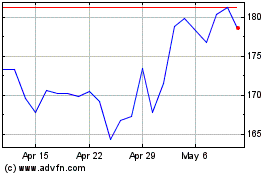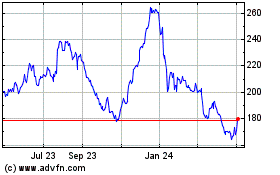By Andy Pasztor and Andrew Tangel
Boeing Co. got a tentative personal endorsement for fixes to its
beleaguered 737 MAX from the head of the Federal Aviation
Administration after he personally took one of the jets on a test
flight.
"I like what I saw on the flight this morning," said FAA
Administrator Steve Dickson, a former Air Force aviator and senior
airline pilot, after sitting behind the controls for a two-hour
ride over parts of the Pacific Northwest, accompanied by a handful
of pilots who work for Boeing and the FAA.
The agency is in the final phase of a drawn-out process vetting
hardware and software changes to the MAX, particularly to an
automated flight-control system that led to two fatal crashes in
2018 and 2019.
"I felt very comfortable. I felt very prepared based on the
training," Mr. Dickson, still wearing his blue FAA flight suit,
told reporters, referring to Boeing's proposed ground-simulator
training sessions for pilots that would get the MAX back in the
air. "We're in the homestretch, but it doesn't mean we're going to
take shortcuts."
Wednesday's flight -- which Mr. Dickson pledged months ago to
perform -- is one of the last steps intended to allay passengers'
concerns about the MAX's safety before the FAA is expected to clear
the aircraft to resume commercial operations.
"We still have some work to do yet" to respond to public
comments and finalize all of the airplane and training revisions,
Mr. Dickson said. Asked about faltering public confidence in the
FAA's latest oversight of the MAX, the agency's chief responded, "I
don't think you ever stop trying to earn the trust of the
public."
With preliminary support from international air-safety
regulators already in hand and final details of pilot-training
changes expected to be ironed out in coming weeks, the MAX fleet
could secure approval as early as November to return to commercial
service. Widespread passenger flights across the U.S., Europe,
Canada and other regions could follow around the end of the year,
based on internal FAA and carrier timelines.
"There is very little daylight between the authorities on this
project," Mr. Dickson said.
Even after regulators give the go-ahead, individual airlines
will have to complete maintenance checks, conduct
operational-readiness flights and put pilots through extra
ground-based flight-simulator training before starting to carry
passengers again.
Mr. Dickson's unusual flight coincided with the House
Transportation Committee's approval of a bipartisan bill -- weaker
than earlier Democratic proposals -- intended to prevent a repeat
of FAA and Boeing mistakes that ultimately led to a global MAX
grounding in March 2019. Two fatal crashes of the twin-engine jet
within less than five months of each other took 346 lives, created
the biggest corporate crisis in Boeing's 104-year history and
threatened the FAA's stature as the world's pre-eminent air-safety
authority.
Passed on a voice vote with no amendments, the legislation
distills findings of a lengthy investigation by the panel's
Democratic majority, which blamed the FAA and the Chicago plane
maker for missing repeated opportunities -- and lacking adequate
internal safeguards -- to eliminate safety hazards before the
crashes. An automated flight-control feature called MCAS misfired,
overwhelming manual pilot commands and putting both jets into
steep, unrecoverable nosedives.
The bill expands FAA authority to choose and supervise Boeing
employees, called designees, delegated to approve safety systems on
behalf of the government. It also introduces stepped-up
whistleblower protections and civil fines if manufacturers fail to
fully disclose details of essential flight-control systems or seek
to interfere with decisions by FAA designees.
The legislation calls for additional FAA funding and personnel
to handle increasingly sophisticated cockpit automation. But it
doesn't include a proposed provision that would have barred
manufacturers from piggybacking regulatory approvals for heavily
modified versions of certain decades-old plane designs -- as Boeing
did when it created the MAX, a variant of a model that had been in
service since the late 1960s.
The bill calls on outside experts to advise the FAA for the
first time about Boeing's safety culture.
Rep. Peter DeFazio, the Oregon Democrat who is chairman of the
committee, alleged during discussion of the bill Wednesday that
Boeing's corporate "culture of profits at any cost" might have
contributed to company design and communication missteps that left
the FAA largely in the dark about MAX safety hazards.
Echoing conclusions from the panel's sharply worded
investigative report released earlier this month, Mr. DeFazio said
the FAA was "unable or unwilling to conduct rigorous oversight" of
the MAX. The bill "will fix the broken system," he said, predicting
a vote on the House floor later this year.
A Boeing spokesman said the company was grateful for the FAA's
"rigorous process that will lead to the safe return to service of
the 737 MAX" and is ready to meet other requirements set by the
agency and international regulators.
Getting a similar bill to the Senate floor this year appears
significantly less likely, according to industry and government
officials tracking the legislation. The Senate Commerce Committee
hit a stalemate earlier this month over a similar measure that was
abruptly pulled from consideration.
Though supporters portray the House bill as a comprehensive
reform of FAA procedures for certifying the safety of an array of
newly designed aircraft, most of the provisions stem directly from
specific aspects of the MAX saga. Many of the proposed changes were
prompted by technical errors, unfounded assumptions regarding pilot
reaction times and various regulatory loopholes documented by the
committee and outside groups during the crisis.
Meantime, the FAA has taken limited steps independently to
improve internal safeguards and communications while protecting
lower-level employees from undue pressure from agency managers.
Write to Andy Pasztor at andy.pasztor@wsj.com and Andrew Tangel
at Andrew.Tangel@wsj.com
(END) Dow Jones Newswires
September 30, 2020 18:11 ET (22:11 GMT)
Copyright (c) 2020 Dow Jones & Company, Inc.
Boeing (NYSE:BA)
Historical Stock Chart
From Mar 2024 to Apr 2024

Boeing (NYSE:BA)
Historical Stock Chart
From Apr 2023 to Apr 2024
